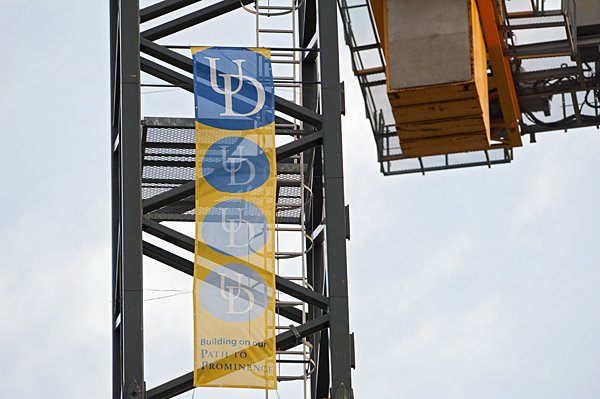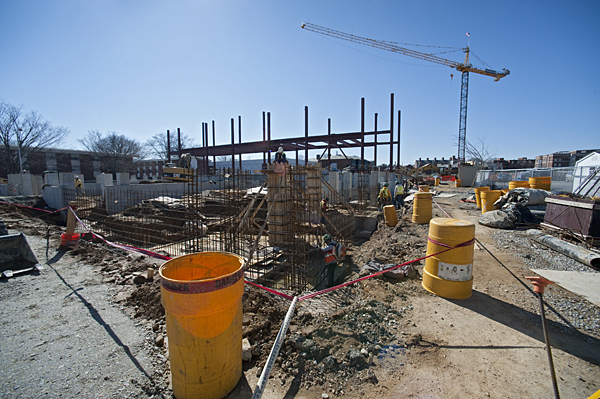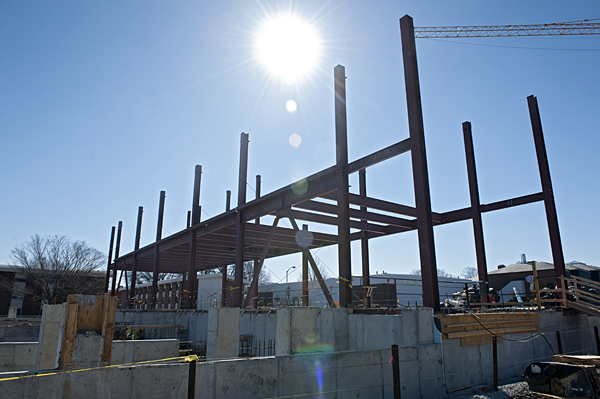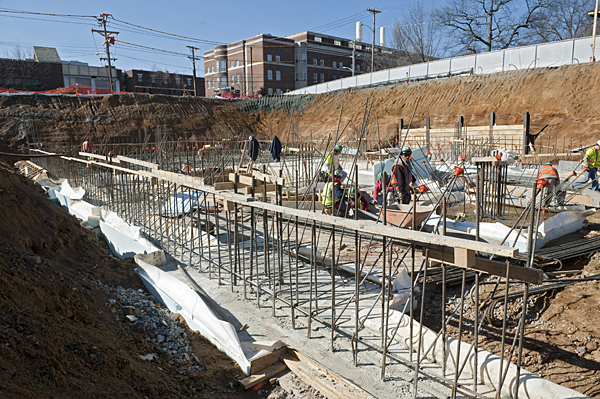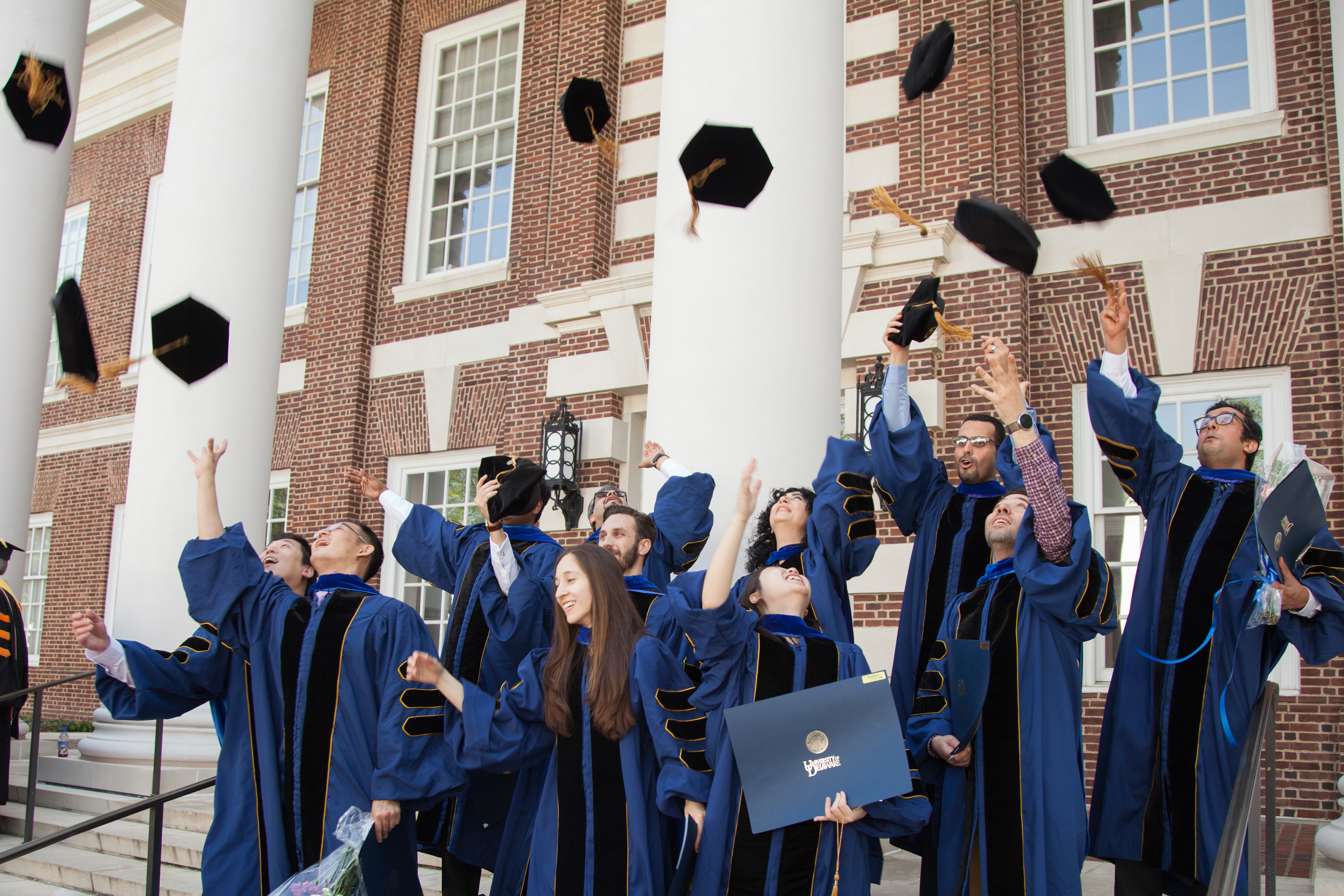Focus on UD’s footprint
Green construction diverts 75 tons from landfill
1:08 p.m., April 18, 2011--Rebar juts from concrete and stretches toward the sky at the corner of Academy Street and Lovett Avenue like crocuses in springtime, signaling new growth at the University of Delaware.
The East Campus Utility Plant (ECUP) is taking shape, part of a larger project that also includes the new Interdisciplinary Science and Technology Laboratory (ISE Lab).
Campus Stories
From graduates, faculty
Doctoral hooding
With UD’s green construction efforts, these projects have diverted 82 percent, or 75 tons of waste from landfills, according to Whiting Turner, the company leading construction.
“That’s 150,000 pounds of bricks and mortar,” explained Larry McGuire, senior project manager for UD’s Facilities Planning and Construction.
Using UD’s single stream recycling system, where all materials are put into one container then sorted and recycled off-site, Whiting Turner and UD set a recycling goal of 75 percent for the project. Recycled materials include blacktop, soil, wood, steel, drywall and other construction by-products.
In conjunction with the University’s Path to Prominence and the climate action plan, UD is using Leadership in Energy and Environmental Design (LEED) practices.
“UD is incorporating LEED and green design principles in all projects as a measure of environmental stewardship,” added Kathy Comisiak, Facilities Planning and Construction associate director.
Main focus conservation, sustainability
Energy conservation initiatives in the ISE Lab project include reducing water usage, capitalizing on natural lighting and using recycled materials.
Comisiak said that as a common practice, the University includes recycled and locally available materials in its project specifications.
“We’re doing our part to ensure the University’s carbon footprint remains as small as possible,” she added, citing improved life cycle costs of the building and equipment as other important benefits.
ECUP, for example, uses highly efficient, variable speed chillers to cool University buildings by rejecting heat and sending it to the ISE Lab where it satisfies a portion of the building’s usage needs. Additionally, the planned installation of two 35KV electric feeders from a city substation to ECUP will increase the capacity and reliability of electric service to campus.
McGuire said the entire ISE Lab building has been designed to save energy, from motors with variable frequency drives that control energy use based on demand and occupancy to proximity sensors that power off equipment and lights when laboratories are empty.
The ISE Lab also features three “green roofs” where indigenous plants and succulents are used to reduce the amount of heat absorbed by a traditional roof, in turn reducing the building’s energy consumption. Green roofs also filter and reduce storm water runoff from buildings, said McGuire.
Thin film solar panels on the clerestory roof in the east wing are an educational addition that demonstrates the future of photovoltaics to students.
Storm water management adds to the sustainable architecture by directing rainwater and pavement runoff—that would otherwise be diverted into the city sewer system—toward areas with plants.
Other sustainability efforts include preserving indoor air quality during construction to safeguard construction workers by using filters on ductwork and commissioning of equipment to ensure that systems work as designed.
“This is the first shining example of what is to come,” said Peter Krawchyk, UD Facilities Planning and Construction director.
However, UD has put recycling initiatives at the forefront of other construction projects on campus with the Gilbert Hall demolition project recycling 96 percent of material.
On the Science and Technology campus, formerly the Chrysler Newark Assembly Plant, demolition has been underway for less than a year and nearly 70,000 tons of materials, predominately concrete and steel, have been recycled from the 272-acre site. 1743 Holdings, a wholly owned subsidiary of the University of Delaware, and URS Corp., the demolition contractor for the site, set a 95 percent recycling goal and are just shy of achieving 90 percent so far.
ECUP construction is approximately 20 percent complete, with plans to have the plant operational by February 2012. The ISE Lab is slated to open May 2013.
For more information on the ISE Lab project, visit the website.
Article by Karen B. Roberts
Photos by Evan Krape






